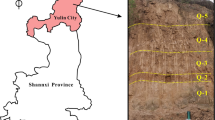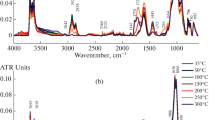Abstract
Spontaneous combustion of coal seams can produce very high temperature (generally between 600 and 850 °C, even reach to 1000 °C), which greatly changes the properties of the surface loess layer, such as its magnetic susceptibility and chromaticity. In order to study a fast, effective and nondestructive method to determine the influence range of coal seam spontaneous combustion zone, and to provide important clues for the development and utilization of coal seam and burnt rock, the mass-specific magnetic susceptibility (χ) and redness chromaticity (Δa) of loess samples were measured after heating to 100 °C, 200 °C, 300 °C, 400 °C, 500 °C, 600 °C, 700 °C, 800 °C or 900 °C in a furnace. The results show that the redness chromaticity of loess increases linearly with temperature in the range of 300–900 °C, and the mass-specific magnetic susceptibility decreases suddenly above 700 °C. These changes in mass-specific susceptibility and redness chromaticity with temperature are related to the degree of iron compounds conversion.










Similar content being viewed by others
Availability of data and materials
All data generated or analysed during this study are included in this published article.
References
Aveling E (1997) Magnetic trace of a giant henge. Nature 390(6657):232–233
Beatrice C, Coïsson M, Ferrara E, Olivetti ES (2008) Relevance of magnetic properties for the characterisation of burnt clays and archaeological tiles. Phys Chem Earth 33:458–464
Chen XL, Fang XM, An ZH, Han WX, Wang X, Bai Y, Ye H (2007) An 8.1ma calcite record of asian summer monsoon evolution on the chinese central loess plateau. Sci China Ser D 50(3):392–403
Dalan RA (2001) A magnetic susceptibility logger for archaeological application. Geoarchaeology 16(3):263–273
Dalan RA (2008) A review of the role of magnetic susceptibility in archaeogeophysical studies in the usa: recent developments and prospects. Archaeol Prospec 15(1):1–31
Dalan RA (2014) Magnetic susceptibility of soils and sediments in environmental archaeology. Springer, New York, pp 1–3
Dearing JA, Bird PM, Dann RJL (1997) Secondary ferromagnetic minerals in Welsh soils: a comparison of mineral magnetic detection methods and implicaions for mineral formation. Geophys J Int 130:727–736
Dekkers MJ (1989a) Magnetic properties of natural goethite I. Grain size dependence of some low and high field related rock magnetic parameters measured at room temperature. Geophys Jour 97:323–340
Dekkers MJ (1989b) Magnetic properties of natural pyrrhotite. II. High and low temperature behaviors of Jrs and TRM as a function of grain size. Phys Earth Planet Inter 57:266–283
Deng J, Wang K, Zhai XW (2014) Study on the oxidation and spontaneous combustion characteristics of jurassic coal in north shaanxi. Adv Mater Res 977:124–128
Dijkstra TA (2001) Geotechnical thresholds in the Lanzhou loess of China. Quatern Int 76(1):21–28
Donato DI, Lazzara G, Milioto S (2010) Thermogravimetric Analysis. J Therm Anal Calorim 101(3):1085–1091
Dunlop D, Ozdemir O, MD Fuller (1998) Rock magnetism: Fundamentals and frontiers. Phys Today 51(9):64–66
Fukasawa T, Iwatsuki M, Furukawa M (1993) State analysis and relationship between lattice constants and compositions including minor elements of synthetic magnetite and maghemite. Anal Chim Acta 281(2):413–419
Gautam P, Blaha U, Appel E, Neupane G (2004) Environmental magnetic approach towards the quantification of pollution in kathmandu urban area, nepal. Phys Chem Earth, Parts a/b/c 29(13–14):973–984
Hannam JA, Boyle JF, Dearing JA, Blundell A (2010) Testing competing hypotheses for soil magnetic susceptibility using a new chemical kinetic model. Geology 38(12):1059–1062
Heller F, Evans ME (1995) Loess magnetism. Rev Geophys 33(2):211–240
Heller F, Liu TS (1986) Palaeoclimatic and sedimentary history from magnetic susceptibility of loess in china. Geophys Res Lett 13(11):1169–1172
Jordanova N, Jordanova D, Barrón V, Lesigyarski D, Kostadinova-Avramova M (2019) Rock-magnetic and color characteristics of archaeological samples from burnt clay from destructions and ceramics in relation to their firing temperature. Archaeol Anthrop Sci 11:3595–3612
Kaevitser EV, Kaloshkin SD, Jalnin BV, Tcherdyntsev VV, Baldokhin TV (2004) The study of structural relaxation kinetics in amorphous alloy fe73.5nb3cu1si13.5b9 using curie temperature measurements. Mat Sci Eng A 375–377:683–687
Kosaka K (1998) The use of magnetic susceptibility in the survey of engineering geology. J Jpn Soc Eng Geol 39(2):208–216
Krainov MA, Kravchinskii VA, Peck JA, Sakai H, Kuz’Min MI (2001) Paleoclimate record in bottom sediments of lake baikal, from magnetic susceptibility data. Geol Geofiz 42(1):87–97
Kuz’min MP, Larionov LM, Kondratiev VV, Kuz’mina MYu, Grigoriev VG, Kuz’mina AS (2017) Burnt rock of the coal deposits in the concrete products manufacturing. Magazine Civil Eng 08(76):170–181
Kuz’min MP, Larionov LM, Kondratiev VV, Kuz’mina MYu, Grigoriev VG, Kuz’mina AS (2018) Use of the burnt rock of coal deposits slag heaps in the concrete products manufacturing. Constr Build Mater 179:117–124
Kuz’min MP, Chu PK, Qasim AM, Larionov LM, Kuz’mina MYu, Kuz’min PB (2019) Obtaining of Al-Si foundry alloys using amorphous microsilica-Crystalline silicon production waste. J Alloy Compd 806:806–813
Li Z, Stevens JG (1996) The origin of magnetism of loess deposits. Scientia Geologica Sinica 4:523–531
Li YL, Wang TH, Su LJ (2015) Determination of bound water content of loess soils by isothermal adsorption and thermogravimetric analysis. Soil Sci 180(3):90–96
Li ZJ, Wei SS, Han JJ (2017) The comparative analysis of physico-chemical properties of physico-chemical properties of loess from Xin Jiang and Shaanxi, China (in Chinese). Land Develop Eng Rexearch 2(4):37–43
Liu QS (2004) Mechanism of the magnetic susceptibility enhancements of the chinese loess. J Geophys Res Solid Earth 109:B12107–B12112
Liu MX, Liu DS, Heller F, Xu TC (1990) Frequency-dependent susceptibility of loess and quaternary paleoclimate (in Chinese). Quaternary Sci 01:42–50
Liu MX, Liu DS, Heller F, Xu TC (1992) Study on magnetic susceptibility of loess and quaternary climate in China (in Chinese). Chin J Geol A12(S1):279–285
Liu QS, Banerjee SK, Jackson MJ, Maher BA, Pan YX, Zhu RX, Deng CL, Chen F (2004a) Grain sizes of susceptibility and anhysteretic remanent magnetization carriers in chinese loess/paleosol sequences. J Geophys Res-Atmos 109:B03101-B3116
Liu QS, Jackson MJ, Yu YJ, Chen F, Deng CL, Zhu RX (2004b) Grain size distribution of pedogenic magnetic particles in Chinese loess/paleosols. Geophys Res Lett 31:L226032–L226034
Liu QS, Deng CL, Yu YJ, Torrent J, Jackson MJ, Banerjee SK, Zhu RX (2005) Temperature dependence of magnetic susceptibility in an argon environment: implications for pedogenesis of chinese loess/palaeosols. Geophys J Int 161:102–112
Liu Y, Tueysuez H, Jia CJ, Schwickardi M, Rinaldi R, Lu AH, Schmidt W, Schuth F (2010) From glycerol to allyl alcohol: iron oxide catalyzed dehydration and consecutive hydrogen transfer. Chem Commun 46(8):1238–1240
Liu Z, Liu FY, Ma FL, Wang M, Bai XH, Zheng YL, Yin H, Zhang GP (2016) Collapsibility, composition, and microstructure of loess in china. Can Geotech J 53:673–686
Nishino Y, Sawa T, Ebara K, Itoh H (1989) Characterizations of reactions of nickel with iron hydroxides and oxides in high-temperature water. Dehydration rate of iron hydroxides and effect of iron chemical form. KAGAKU KOGAKU RONBUNSHU 15(2):276–283
Ponomar VP (2018) Synthesis and magnetic properties of magnetite prepared by chemical reduction from hematite of various particle sizes. J Alloy Comp 741:28–34
Qiang W, Fan S, Zhou W, Liu S (2013) Application of the analytic hierarchy process to assessment of water inrush: a case study for the No. 17 coal seam in the sanhejian coal mine, china. Mine Water Environ 32(3):229–238
Randrianantoandro N, Laffez P, Sella C, Greneche JM (2000) Structural and magnetic properties of iron oxides in co-sputtered granular thin films. Euro Phys J Appl Phys 9(2):125–130
Randrianantoandro N, Mercier AM, Hervieu M (2001) Direct phase transformation from hematite to maghemite during high energy ball milling. Mater Lett 47(3):150–158
Rees AI (1965) The use of anisoteopy of magnetic susceptibility in the estimation of sedimentary fabrici. Sedimentology 4(4):257–271
Schimanke G, Martin M (2000) In situ xrd study of the phase transition of nanocrystalline maghemite (γ-Fe2O3) to hematite (α-Fe2O3). Solid State Ionics 136–137(1–2):1235–1240
Smirnov VN (2013) Rate constants of the reaction Fe+O2+M=FeO2+M in the low- and high-pressure limits. Russ J Phys Chem B 7(2):105–112
Šubrt J, Hanousek F, Zapletal V, Lipka J, Hucl M (1981) Dehydration of synthetic lepidocrocite (γ-feooh). J Therm Anal 20(1):61–69
SunYB CTH, Xie QQ (2009) Magnetic susceptibility of the xifeng section and its paleoclimate significance. Chin J Geochem 28:81–85
Swaddle TW, Oltmann P (1980) Kinetics of the magnetite–maghemite–hematite transformation, with special reference to hydrothermal systems. Rev Can De Chimie 58(17):1763–1772
Verosub Kenneth L, Fine Pinchas (1993) Pedogenesis and paleoclimate: interpretation of the magnetic susceptibility record of chinese. Geology 21(11):1011–1014
Wang JY, Zhang XL, Zhang TZ (2017) Study on the dehydration reaction kinetics of Guyang limonite (in Chinese). Conserv Util Miner Resour 5:49–53
Winkler E (2013) Stone in architecture: properties, durability [M]. Springer Science and Business Media
Zeng YY, Zhao B (2020) Paleoclimate implication of magnetic susceptibility in the loess-paleosol will enlighten studying on the paleoclimate of the red soils in southern China (in Chinese). Prog Geophys 35(5):1717–1723
Zhang YS, Qu YX (2004) Quantitative research on clay mineral of the Malan loess from the Loess Plateau in China (in Chinese). Geologcial Rev 50(5):530–537
Zhang Y, Guo Z, Deng C, Zhang S, Wu H, Zhang C, Ge J, Zhao D, Li Q, Song Y, Zhu R (2014) The use of fire at Zhoukoudian: evidence from magnetic susceptibility and color measurements. Chin Sci Bull 59(10):1013–1020
Zheng Q, Zhang YB, Wu AJ, Shi H, Chang C (2020) Experimental study on the adsorption of acid mine drainage using Malan loess (in Chinese). Sci Technol Eng 20(3):1277–1282
Acknowledgements
This research was supported by the Opening Project of Key Laboratory of Coal Resources Exploration and Comprehensive Utilization, Ministry of Natural Resources (No. KF2021-7), National Science Foundation of China (No. 41672279), Natural Science Basic Research Program of Shaanxi Province(No. 2020JQ-744), China Postdoctoral Science Foundation (No. 2020M673443) and the Excellent Doctoral Dissertation Cultivation Program of Xi 'an University of Science and Technology.
Funding
Opening Project of Geological Research Institute for Coal Green Mining (grant no. MTy2019-13); National Science Foundation of China (grant no. 41672279).
Author information
Authors and Affiliations
Contributions
WSF and SQ designed the experiment, and WSF was a major contributor in writing the manuscript. WNQ analyzed and interpreted the experiment data regarding the magnetic susceptibility and chromaticity of loess. LT and ZH performed the operation of the experiment. All authors read and approved the final manuscript.
Corresponding author
Ethics declarations
Conflict of interest
The authors declare that they have no competing interests.
Rights and permissions
About this article
Cite this article
Wang, S., Sun, Q., Wang, N. et al. Responses of the magnetic susceptibility and chromaticity of loess to temperature in a coal fire area. Acta Geod Geophys 56, 425–437 (2021). https://doi.org/10.1007/s40328-021-00349-1
Received:
Accepted:
Published:
Issue Date:
DOI: https://doi.org/10.1007/s40328-021-00349-1




